I am a member of the Dutch association of wine connoisseurs (Verenigde Vinologen Nederland). As a member of the travel committee of the VVN, I organize wine trips to Italy together with Fred Nijhuis. This is the second day of our tour of Friuli. Click here for my account of our first day.
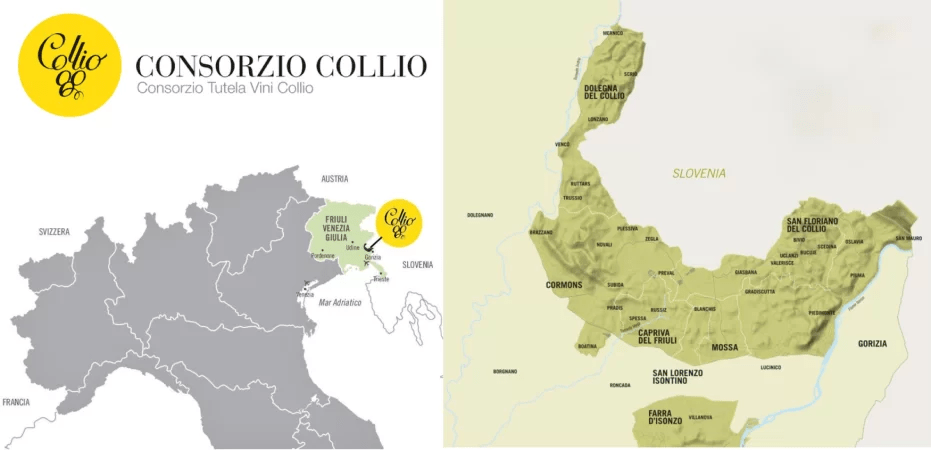
Collio was one of earliest DOCs to be established in Italy, in 1968. The full name is Collio Goriziano. It is in the province of Goriziano, a half moon shape between Slovenia to the north and the Isonzo river to the south. We started our exploration of this DOC with a visit to the Collio Consorzio in the Enoteca di Cormóns.

Lavinia Zamaro, the director of the Consorzio, gave us an overview of the DOC. The whole area is 8000 ha, of which 1300 ha (3200 acres) is planted with vineyards (16%). All wines are white. Collio produces 7 million bottles of wine per year, of which 25% Pinot Grigio, 17% Friulano, and 15% Ribolla Gialla. All allowed varieties for the DOC can be used for a blend that is called Collio Bianco. Every producer makes a Friulano, which is the main variety of the DOC.
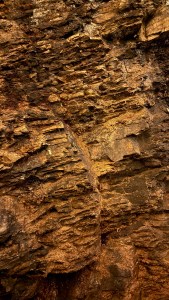
The local soil is called ponca, which is layers of sandstone with marl. It has the ability to drain water well, so the vines have to work hard to develop deep roots. At the same time, deep water reserves protect the vineyards from draught. Collio means hills and only vineyards that are on the hillside are allowed for the DOC. Vineyards on a slope means that most of the work has to be done by hand rather than machines.
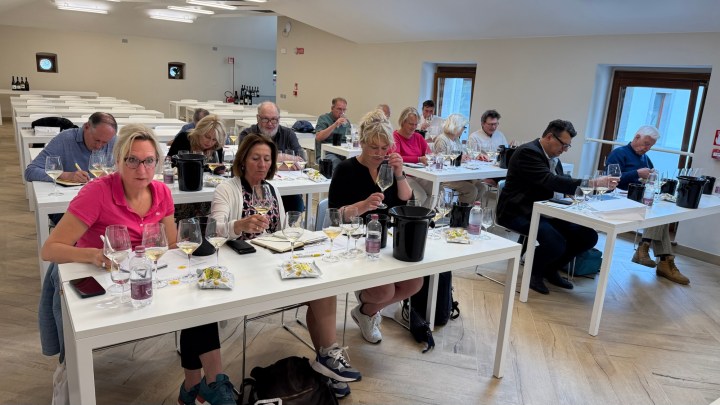
There are 300 producers of grapes and 120 producers of wine. A special bottle shape has been designed for Collio, which is not mandatory but used by many producers. It has a more narrow neck than usual, forcing the cork to be more tight and thus allowing less oxygen into the wine. The top of the capsules often has the yellow logo of Collio.
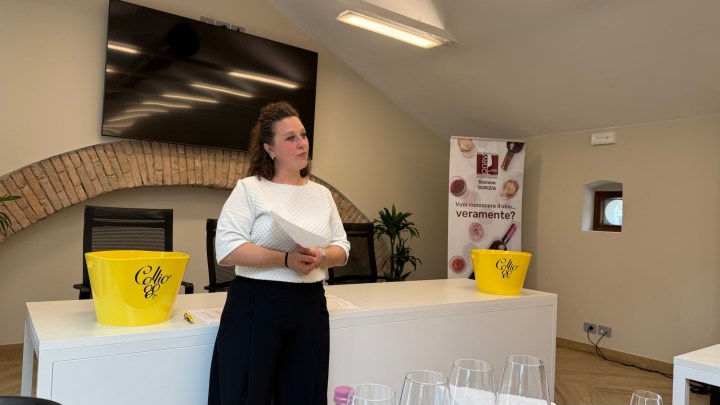
We tasted 8 different wines of each type (Ribollo Gialla, Friulano, Pinot Grigio, Collio Bianco), so 32 wines in total. This gave us a great overview of what Collio DOC is like. The wines can age well, and producers bring the wine to market when it is ready to drink. So in some cases the current vintage is 2021 or even 2019.
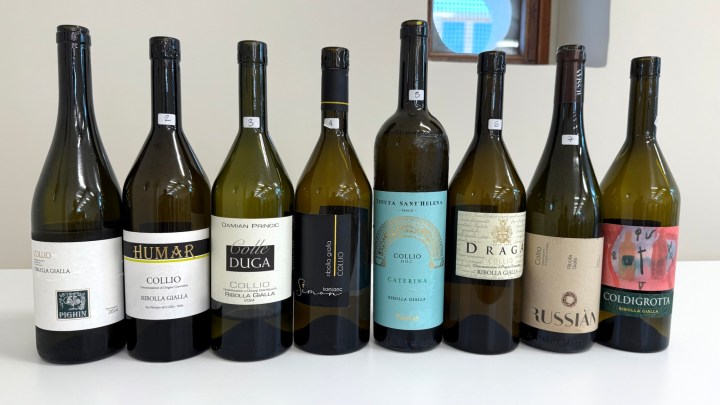
We started with Ribolla Gialla:
- Pighin Collio Ribolla Gialla DOC 2024 (stainless steel): fresh and crisp.
- Humar Collio Ribolla Gialla DOC 2024 (4 days maceration): earthy, tannins from the skin contact.
- Colle Duca Collio Ribolla Gialla DOC 2024 (short maceration, part in French oak barrels and part in steel): peach, fresh.
- Simone Komjanc Collio Ribolla Gialla DOC 2024 (late harvest, small barrels): ripe fruit, salty.
- Fantinel Tenuta Sant’Helena Collio Ribolla Gialla DOC 2024 Caterina (stainless steel): yellow apple, almond.
- Draga Collio Ribolla Gialla DOC 2023 (24 hour maceration, 7 months stainless steel on the lees): earthy, tannins from the skin contact.
- Russiàn Collio Ribolla Gialla DOC 2023 (stainless steel): salty.
- Coldigrotta Collio Ribolla Gialla DOC 2021 (stainless steel and amphora): ripe fruit, structure, fresh, complex.
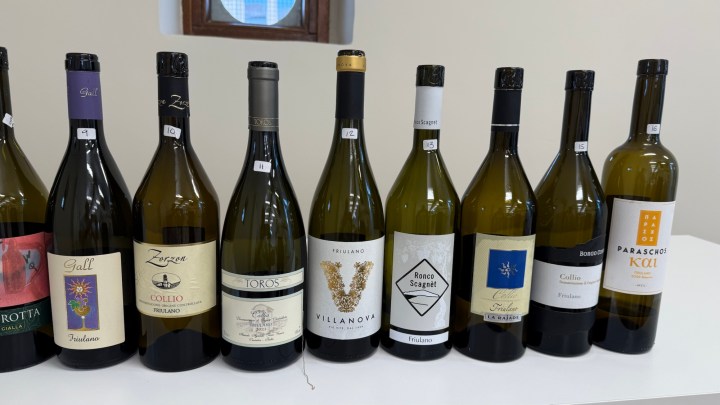
We continued with Friulano. It needs time in the bottle, which is why most wines we tasted where from 2023 or 2022 rather than 2024.
- Gall Collio Friulano DOC 2024 (stainless steel): mineral, salty.
- Zorzan Collio Friulano DOC 2024 (8 hours skin contact, 6 months stainless steel): aromatic, fresh, structure.
- Toros Collio Friulano DOC 2023 (stainless steel, stirring of the lees): ripe, developed, earthy.
- Villanova Collio Friulano DOC 2023 (8 months stainless steel on the lees): aromatic, tropical fruit, floral, fresh
- Ronco Scagnèt Collio Friulano DOC 2023 (skin contact 5 hours, 6 months on the lees): earthy.
- La Rajade Collio Friulano DOC 2023 (skin contact, stainless steel): structured.
- Borgo Conventi Collio Friulano DOC 2023 (small percentage skin contact, stainless steel): developed, aromas like a natural wine.
- Paraschos Collio Friulano Riserva DOC 2022 Kai (2 days skin contact, aged 2 years on lees in large oak, no added sulphites and without filtration): natural wine, developed.

Next Pinot Grigio. As the name implies, the color of the grapes is between white (Bianco) and red (Nero). When a bit of the color from the Pinot Grigio grapes is extracted into the wine by maceration, the wine obtains a hint of copper and is called ramato in Italian (ramo = copper).
- Grappoli Collio Pinot Grigio DOC 2024 Ascevi Luwa (short skin maceration, 6 to 7 months on lees in steel): pink hue, peach, fresh and soft.
- Skok Collio Pinot Grigio DOC 2023 (24 to 36 hours skin contact, 7 months on lees in steel with stirring): structured, salty.
- Fruscalzo Collio Pinot Grigio DOC 2023 (8 months on lees in steel with stirring): amber-gold with a hint of copper, fresh.
- Sturm Collio Pinot Grigio DOC 2023 (cold maceration, part in steel and part in 500 liter oak barrels, few months on the lees): earthy, structure.
- Subida di Monte Collio Pinot Grigio DOC 2023 (stainless steel on the lees for 6 months): structured, balance.
- Castello di Spessa Collio Pinot Grigio DOC Joy 2022 (10-15 hours skin maceration, 6 months stainless steel on the lees): rosé, earthy, full-bodied.
- Tercic Collio Pinot Grigio DOC Dar 2022 (20 hours skin maceration, 9 months on the lees in French barriques, of which 20% new): golden, structured, salty.
- Renato Keber Collio Pinot Grigio DOC 2019 (light skin maceration, 12 months in stainless steel, 10% fermented in barrique): developed, complex, nice.
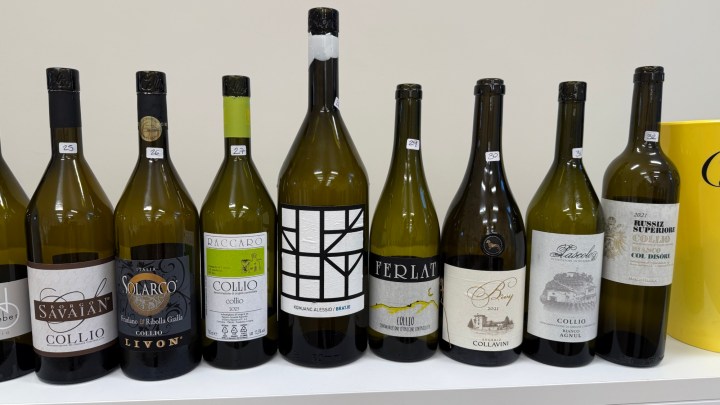
We ended with Collio Bianco, in which all allowed grape varieties of the DOC may be blended to create the producer’s expression of the terroir.
- Borgo Savaian Collio Bianco DOC 2024 (60-70% Friulano, Ribolla Gialla, Pinot Grigio, in glass for 3 months): light, apple.
- Livon Collio Bianco DOC 2023 Solarco (Friulano, Ribolla Gialla, Sauvignon Blanc, Pinot Bianco, aged 6 months, 40% in oak barriques, 60% in steel): fresh, structure from the wood, fresh.
- Raccaro Collio Bianco DOC 2023 (Friulano, Sauvignon Blanc, Pinot Grigio, some skin contact only for the Friulano): structure.
- Bratje Collio Bianco DOC 2021 (Ribolla Gialla, Friulano, Malvasia, Picolit, aged in wood for 12 months): oak, tropical fruit, nice.
- Ferlat Collio Bianco DOC 2021 (100% Pinot Bianco, 24 hours skin contact, stainless steel on the lees, with malo): complex, fresh, structure.
- Collavini Collio Bianco DOC Broy 2021 (50% Friulano, 30% Chardonnay, 20% Sauvignon, Friulano and Chardonnay air-dried, Sauvignon brief skin contact, part in steel and part in barriques): astringent.
- Pascolo Collio Bianco DOC Studio di Bianco 2021 (34% Friulano, 33% Sauvignon, 33% Riesling, French oak barriques for 12 months on the lees): earthy, round, full.
- Russiz Superiore Collio Bianco DOC Col Disore 2021 (Pinot Bianco, Friulano, Sauvignon, Ribolla Gialla, cold maceration, 12 months in oak barrels): ripe fruit, lower acidity.
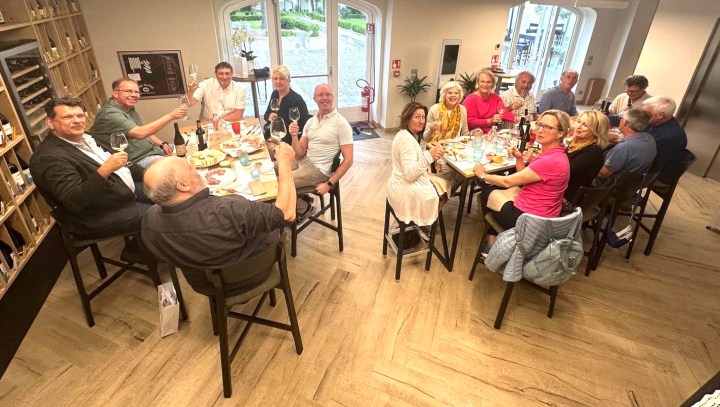
After the tasting we had a lunch of salumi, cheese, salad, and frico at the Enoteca.
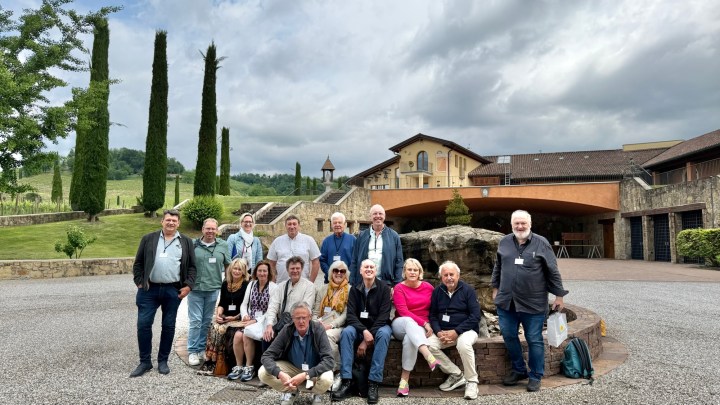
The first winery we visited in the Collio region was Jermann. This was originally a family business by the Jermann family with roots in Vienna, but is now a commercial enterprise that is partly owned by Antinori. In the 1880s, the Jermann family was one of the first wineries in the area to bottle their wine instead of selling it in bulk. What really put Jermann on the map was the Vintage Tunina, a field blend of Sauvignon, Chardonnay, Ribolla Gialla, and Malvasia with a long aging. This wine has won numerous prizes. Jermann produces 1.5 million bottles per year, of which 95% white. Although the vineyards are within the Collio region, only the Picolit is classified as Collio DOC. The Pinot Grigio is classified as Friuli DOC. Vintage Tunina is not a DOC, because field blends were not allowed within Collio or Friuli DOC.
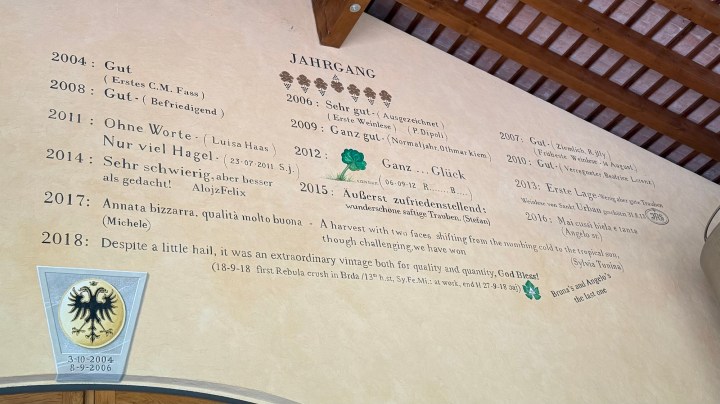
For a while the family made inscriptions in the wall about the harvest quality. This was done in different languages, as the different generations speak different languages. The Austrian roots of the company were clear from German text here and there, and by the strict application of protocol (we all had to wear a tag with the house rules during our visit and I needed to provide ID to be able to get a receipt and pay for our visit). Unfortunately it was only possible to get a standard visit aimed at random tourists, with a long tour of the cellar (which is less interesting if you have seen wine cellars dozens or even hundreds of times before, like everyone in our group), and only a limited amount of wines to taste, including only one of the three crus.

Even though we had just had lunch, the standard tour included more food (salumi, cheese, and polenta). Fred cut the polenta with a piece of string.

The wines we tasted at Jermann were:
- Ribolla Gialla 2022 (aged for 6 months, 90% stainless steel, 10% in large wood): fresh.
- Pinot Grigio 2024 (stainless steel): body, fresh, white fruit.
- Ramât Pinot Grigio 2022 (macerated for 4 hours, 6 months on the lees in stainless steel): copper color, structure, fresh.
- Vintage Tunina 2022: mineral, complex, structure.
- Pignolo 2018 (aged for 3 years in 300 litre barrique): a lot of tannin, but ripe tannin.
Radikon
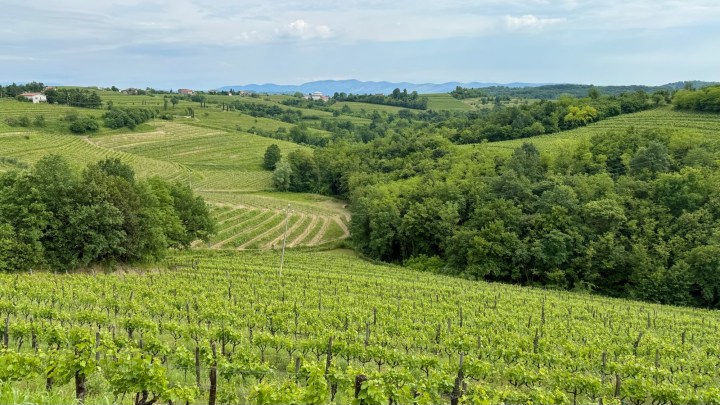
The other winery we visited in Collio was Radikon. This is a real family business with its own character, producing only 90.000 bottles per year from 25 ha (60 acres) of vineyards, partly located in Slovenia. They make ‘natural’ wine with as little intervention as possible. This includes:
- Monitoring the vineyard by registering in an app each individual vine with a problem that needs to be treated, so only those vines are treated.
- Grass in the vineyard to prevent surface erosion.
- No added sulphites, so they have to work very clean.
- Natural fermentation.
- Skin maceration.
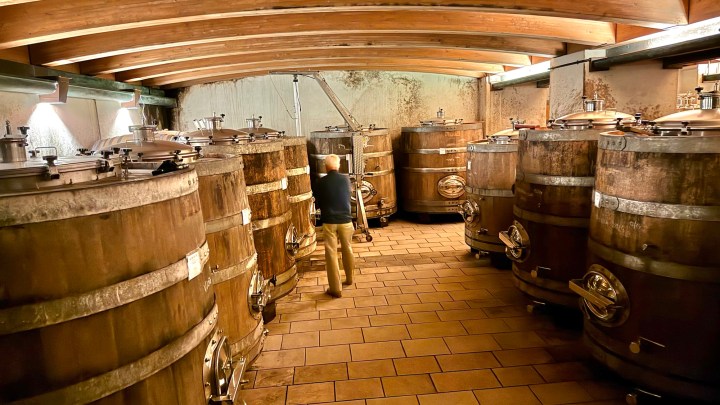
Another important aspect is that they age the wine until it is ready to drink. The longer the skin maceration, the longer aging is needed to get the wines ready. The wines are first aged in large casks…
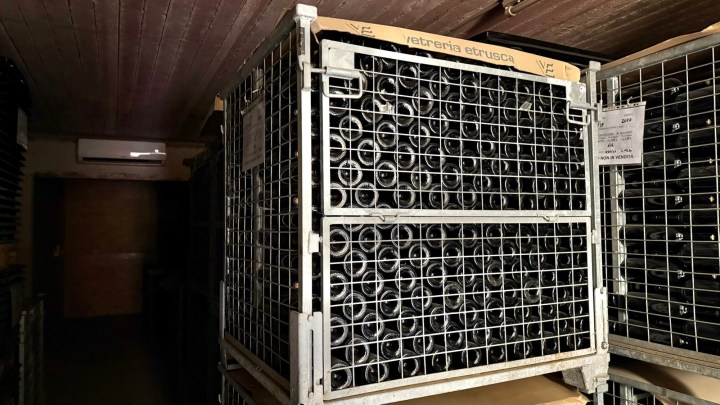
…and then in the bottle. The current vintages on the market are 2020 for whites, 2013 for Pignolo, and 2009 (!) for Merlot.
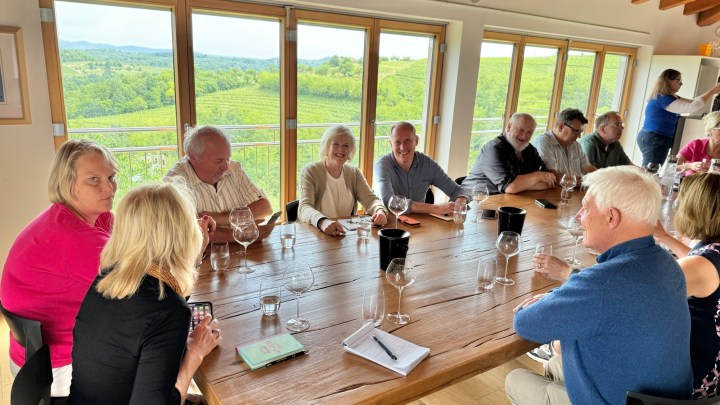
Radikon produces three lines of wines. The “Pop” line is the most approachable because it has the shortest skin maceration (2-4 days), the “S” line is produced from grapes from Slovenia with medium skin maceration (8-14 days), and the “Blue” line undergoes 1-3 months of skin maceration. Radikon produces very original wines with their own character that you either love or hate. Some people in our group loved the wines, but I am in the latter category as the acidity is just too high for me. The Blue line is sold in bottles of 0.5 and 1 litre instead of the usual 0.75 and 1.5 litres. The bottles have a more narrow neck in order to give them the same relative amount of oxygen as a magnum for optimal bottle ripening conditions.
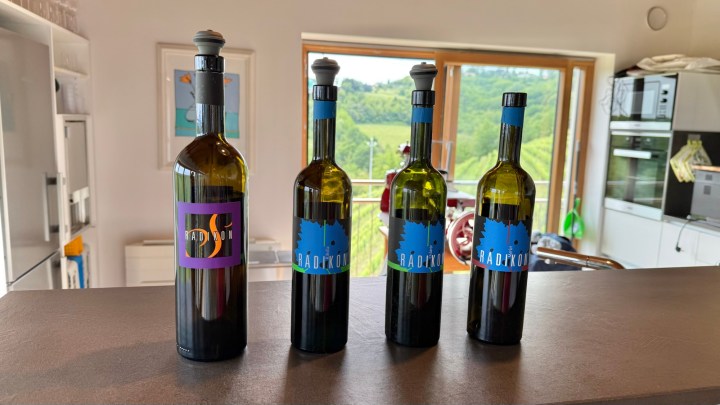
The wines we tasted at Radikon were:
- Slatnik 2022 (S-line, 80% Chardonnay, 20% Friulano, 10 days on the skins together, 1 year in barrel): peach, high acidity.
- Ribolla 2020 (Blue line, 3 months on the skins, 3 years in barrel, 18 months bottle aging): orange wine, high acidity.
- Oslavje 2006 (Blue line, Chardonnay and Sauvignon Blanc, 3 months on the skins, 3 years in barrel, 15 years in bottle): dark orange, high acidity, very developed.
- Merlot 2009 (Blue line, 1 month on the skins 5 years in barrique, 11 years in bottle): brick color, soft tannins, high acidity, very developed.
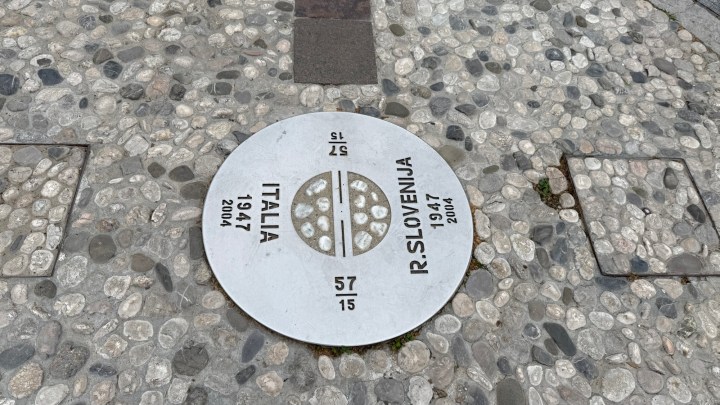
We had some free time between Radikon and dinner, and half the group decided to take the opportunity to take a nice half hour walk through the town of Gorizia to the border with Slovenia. There used to be a wall there as part of the iron curtain. Now that Slovenia is part of the European Union and we have Schengen, you hardly notice the border.
Chincaglieria Gastronomica
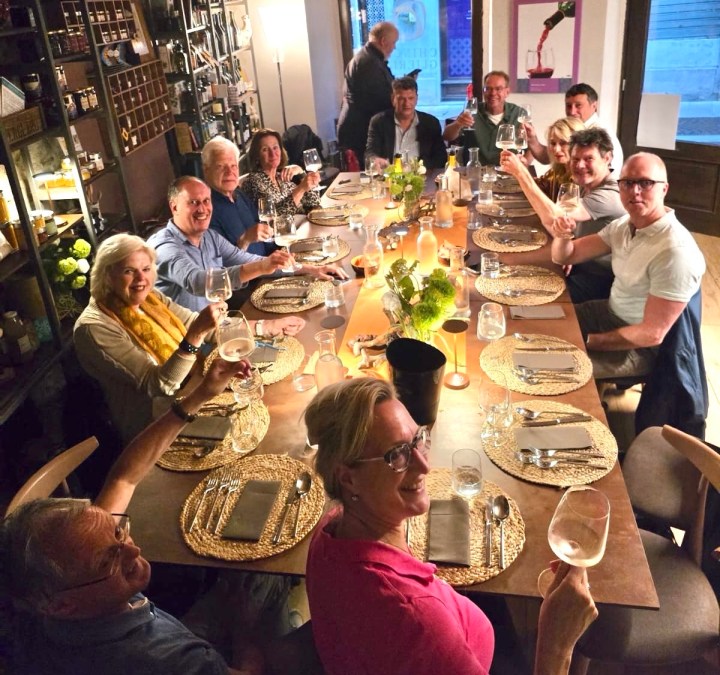
We had dinner at Chincaglieria Gastronomica.

- Foam of green asparagus and sclopit (typical local greens), green and white asparagus, and fried egg yolk
- Risotto with wild herbs and lardo
- Pork fillet with mashed potatoes and horseradish
- Strudelmisù (something between strudel and tiramisù)

- Dario Coos Ribolla Gialla Spumante (charmat method)
- Attems Collio DOC Cicinis 2023 (Sauvignon Blanc)
- Edi Keber Collio Bianca DOC 2022 (70% Friulano, 15% Malvasia, 15% Ribolla Gialla; 20% in large oak barrels, rest in stainless steel)
- Lis Neris Cabernet Sauvignon 2016 Venezia Giulia IGT (6 months in French oak)
- Dario Coos Ramandolo DOCG (Verduzzo passito)


What can an ignoramus like me say 🙂 ? Thank you – I have learned a great deal I did not know! Have driven Venice > Austria thru’ the Dolomites a few times – Friuli must have been east of me. Since I love white wine and have been to Italy a fair few times I must have drunk Friuli wines. Love the undulating scenery. Childishly was amused at the German-written Jermann ‘Jahrgang’ list – well, so > 2006 was ‘sehr gut’ and 2009 only ‘ganz gut’ > ‘very good’ versus ‘pretty OK’ 🙂 ! Brief but succinct! Also had to laugh at the ‘strudelmisu’ . . . hmm, so other countries can ‘muck up’ their languages also . . . glad you had an interesting time this early spring . . .
LikeLiked by 1 person